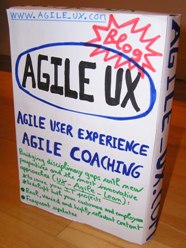Posted by jc-Qualitystreet on 2011/01/21

A very good ROTI given by the participants!
User Story Mapping, Vision, Personas, Specifications Workshops, Guerilla Usability and more … all the activities of the Agile UX practitioner during these two days of training.
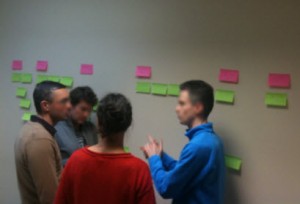
User Story Mapping Workshop
the opportunity for participants to return to foundations (both Agile and UX) but also to learn new techniques, new practices …
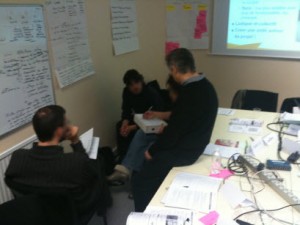
Product Vision Box Workshop
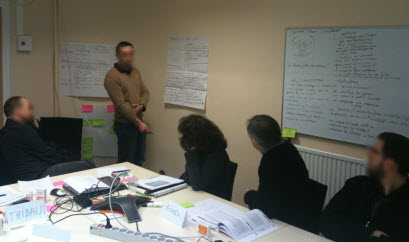
Participant introducing a "pragmatic" persona: Raoul !
the opportunity for a heterogeneous group, composed of 7 Agilists and 3 Usability consultants, to discover each other, learn to work together and ultimately find that Agile UX collaboration works!
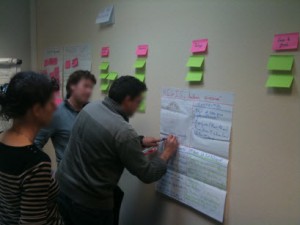
"Regis": a pragmatic Persona under collective construction
In short a great class and a real pleasure to do the training !
More information on this training session (in french)
Posted by jc-Qualitystreet on 2010/12/23
Agile marketing is a new mindset for marketers who adopt agile principles and practices in their daily activities (agile Marketing taskboard: why marketers love it?)
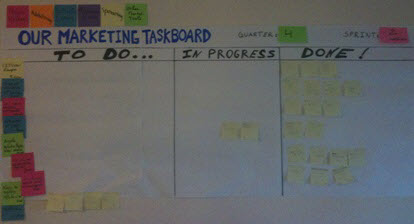
Agile Marketing Taskboard for Marketers
But Agile marketing is first the realization of IT projects for marketing using agile development This kind of project can only succeed and flourish in short cycles, with frequent deliveries, lead by FEEDBACK and open to change.
As pointed out recently Lubomira Rochet (Valtech), proposing the right product to the right person in the right context at the right time is key for digital marketing and to secure competitive advantage in a world where everything is accelerating.
To achieve it, the future of marketing will be primarily to deliver early, to test, test again and again, measuring and continuously adapt. A set of activities very closed to the Kaizen principle (continuous improvements), pillar of Lean thinking, and finally the real challenges which only an agile and lean approach can face with effectiveness and efficiency.
Good… but the agile marketing dynamics doesn’t come without impact and requires reflection.
Impact of Agile marketing 1… Undeniable benefits for Marketing and Business in general…
- Align IT and Business to the same Vision and objectives
- Deliver early and often to get the maximum of value and feedback
- Improve team morale, motivate and engage people
These are the major advantages of agile marketing but not only…
- enhancing the ability to influence the progress of the project, including changing priorities, better managing emerging needs and adapting to an environment of change (via an emergent product backlog);
- improving project visibility through visual management and extensive information radiators
- accelerating time to market through a single objective: getting the most valuable elements as soon as possible;
- getting a better adaptation to user needs through numerous opportunities for feedback, earlier and more frequent interactions, demonstrations and regular deliveries to meet new requirements (Test – Measure – Adaptation)…
are other benefits of agile marketing.
Impact of Agile marketing 2… Duties and the necessity to collaborate…
- Bring EVERYBODY TOGETHER, IT and Marketing, and establish an environment of trust
- Facilitate COOPERATION and foster effective COLLABORATION throughout the project (from the beginning to the end)
- Bring out a new role: the Product Owner with a set of responsibilities
- Empower teams
- Cut projects in short sprints (with a duration of 1 week, 2 or 3 weeks …)
- Establish a delivery cadence
- Test, Test, Test… Inspect and Adapt!
- Do just enough formalism, procedures and seek to eliminate wastes at all levels
Impact of Agile marketing 3… continuous reflection on a delivery cadence
On one hand, delivering earlier and more frequently can generate more revenue (new billing conditions, customer retention or acquisition …).
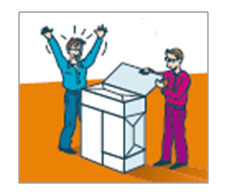
A successful Delivery !
It is also quite suitable for digital marketers that need to test again and again various options and multiple configurations to optimize their conversion rates, to meet user needs, or simply create effective « landing pages ».
On the other hand (and other contexts), switching from one to several releases a year entails additional work. It has a cost and must be prepared. Moving from 1 to 4 releases a year like SalesForce or going to 45 releases like PatientKepper is not easy task. Cost and technical considerations are crucial but other factors should be taken into account:
- The involvement and availability of teams (development, business, support, sales, operations)
- The synchronization effort required
- The capacity to work frequently on the required deployment artifacts
- The willingness of the users to change their habits, to learn new functions, to reinstall applications, to acquire new licensees
- The balance between the desire to initiate a continuous conversation with its users by offering them as regularly as possible new features and the risk of losing these innovations in the mass of multiple announcements about the Product .
- The natural rhythm of the market
So, agile marketing is challenging and involves coordination of many people. Great benefits can be expected but impacts inside or outside the organization don’t have to be underestimated.
Posted by jc-Qualitystreet on
… Because their goal is to create the maximum value for the customer or prospect, as quickly and efficiently as possible;
… Because the Agile and Lean approach is the best way to deliver the right message at the right time to the right person.
Agile marketing is first the realization of IT projects for marketing using agile development… BUT it is also, from another perspective, the adoption of agile values, principles and practices beyond software in Marketing. And that is NEW!

The agile marketing taskboard
After IT teams, this is now the marketing teams who want to become Agile. And some companies have even already taken the opportunity to adopt agility in their own business …
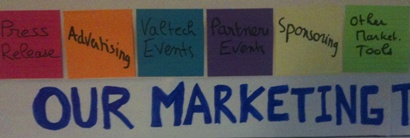
Agile Marketing Themes
The number of examples showing companies applying Agile & Lean practices beyond IT, such as in Communication, Training, Sales, or Marketing increases …
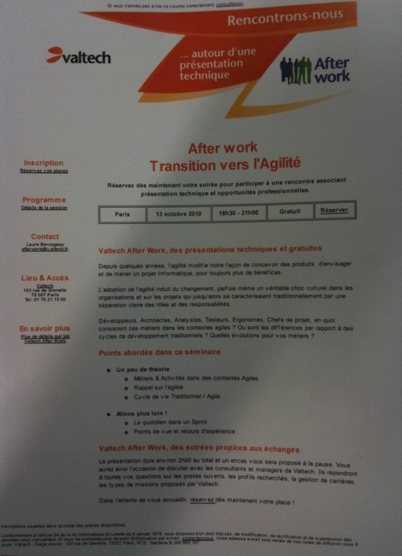
AfterworkAgile: An Agile marketing USER STORY
Via my French blog, I’ve heard about interesting projects outside the context of software development. In addition, my coaching activities enable me to work with Business people (often assigned to the role of Product Owner). Often, these inspiring and smart people quickly detect the potential benefits of Scrum or Kanban, in their daily activities.
See, adopt, adapt and replicate what really works!
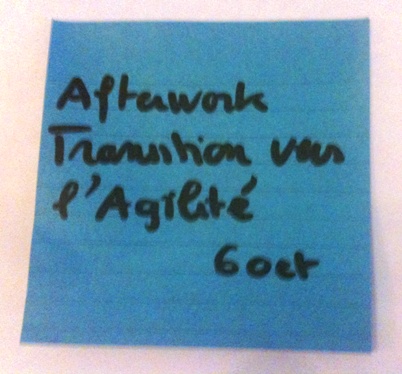
The same user story as a post-it placed in taskboard
The keys of Agile Marketing for marketing teams
- Adopt Agile planning with different levels of details and commitments:
- The Roadmap level (annual)
- The release Level (quarter)
- The Sprint level (with a duration of 3 weeks for Marketing Teams)
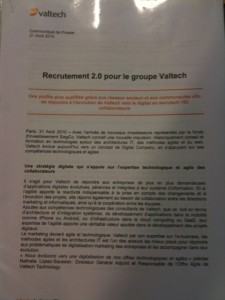
A Press Release User story (item of the sprint)
- Create a Taskboard to visualize and monitor the flow of activity (tasks) during the current Sprint

Taskboard - Quarter - Sprint
- Use visual Management (displaying the taskboard and important marketing tools for a better description, elicitation and understanding)
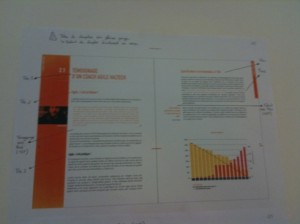
Visual management for marketing actions
- Use short cycles, called sprints. These short period of time (2 or 3 weeks) will also include Scrum ceremonials:
- Planning meeting: 1st day of the Sprint plan for all marketing activities for the next three weeks and the tasks to achieve it
- DailyScrum: Every day in the morning, no more than 10 minutes to synchronize, measure progress and identify impediments
- Sprint Review & Retrospective: Last day of Sprint, to inspect and adapt…
- Focus on Agile values (Courage, Communication, Feedback, Simplicity, Respect) for the team in its way of working together but also in its relations with internal and external partners….
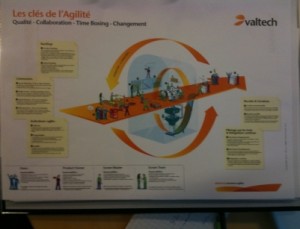
Keys to Agility... not only a User Story 🙂
- Use the user stories (categorized into themes and decomposed tasks that will be moved on the taskboard) for your marketing actions
- Gradually, calibrate your sprints by estimating your user stories, and at the end of each sprint, take the time for continuous reflection and improvement.
Posted by jc-Qualitystreet on 2010/12/21
Guess where in this very high building I gave my Scrum Product Owner training today 🙂
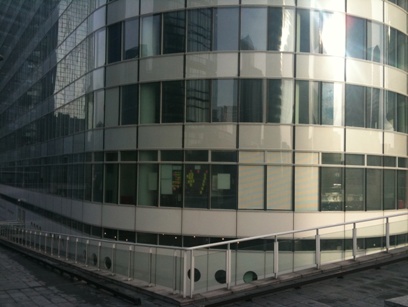
The answer:

And Inside ( only one side of the room !):

Being Agile it’s also being different in terms of environment !
Posted by jc-Qualitystreet on 2010/12/16
The Parking Lot helps to track important items, ideas and issues that may not be useful to discuss at a time in the agenda.
The principle is to return to them later.

Parking Lot in action
The Parking Lot is a simple facilitation tool: you just need a poster and some sticky notes. But it enables you to send strong messages to participants of a workshop:
1. « I’ve heard you »
2. « We won’t forget »
3. « We will talk about it for sure »
Indeed, at the end of the workshop or when the training day ends, we take 10 to 15 minutes to review the items put in the Parking lot with the team.
We seek to identify:
- Items that must be addressed now (AND so we do NOW)
- Items that need to be address but not right now (so they remain in the Parking Lot)
- Items that no longer need to be addressed, for example done (so we remove it…)
Because sometimes it is not the right time… For your training or coaching sessions, the Parking Lot is a really effective tool!



















